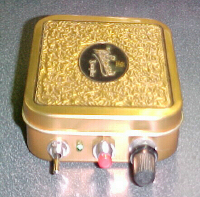
CW Keyers
Here are two different keyers I have built & used. The first uses the Norcal keyer chip. It was built on a small etched PC board about the size of a postage stamp which was installed into a Whitman's Sampler candy box that is slightly larger than an Altoids tin.
I used the larger box to accomodate a 9V battery and speaker. Aside from the keyer chip the only other components used on the board are a 78L05 voltage regulator, a 3904 transistor, one resistor and three capacitors. The schematic can be found in the manual for the keyer which can be downloaded from the Norcal keyer chip page. The Norcal keyer chip uses the very same pinout as the Jackson Harbor Press PK-4 keyer chip, and they can be used interchangeably.
The front panel consists of a power switch & LED, a pushbutton switch for the keyer memory/program, and a pot for the speaker audio. The rear consists of an external power jack, a paddle jack, and a keyer output jack.
The latest keyer I built is an SKC kit from Hendricks QRP kits which I got at the Ozarkcon QRP convention. It is a simple keyer which provides basic iambic keyer function. It has much less complicated programming than the Norcal chip. In fact, the menu only consists of three functions: speed control, tune, and iambic A/B mode.
The kit consists of a small board which easily mounts into a small enclosure or transciever project. I chose to install mine into a "cigarette" case that I bought at a discout store several years ago. I picked up two of the cases with different designs engraved into them, but hadn't used either one. At first I was going to install the keyer into an Altoids tin, but after messing up drilling the holes for the front panel, I decided to use the fancier cigarette box. It is slighly thinner than an Altoids tin but still large enough to hold a 9V battery. I installed a piezo speaker in the side of the case after drilling a small hole. The PC board is held in place by the nut on the 3.5" paddle jack and double-sided foam tape.
The front panel consists of a power switch & LED, the function button, and paddle jack. The rear has the keyer output jack. I decided to use an RCA jack since my other keyer used it, as well as my homebrew straight key. This is so I can use the same cable for each keyer or straight key. I think this goes back to my very first keyer which was the Ramsey CMOS keyer which used an RCA jack for the output. I've just standardized the connections ever since.
Overall, I really like the looks of this keyer. The engraved chromed box works great as an enclosure since it's just large enough, and the thicker metal is more sturdy than an Altoids tin. It's a nice little keyer that I can slip into my pocket.